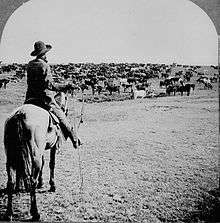Cattle drive
For the 1951 film, see Cattle Drive (1951 film).

A cattle drive is the process of moving a herd of cattle from one place to another, usually moved and herded by cowboys on horses.
Australia
Australia is noted for long drives. Patsy Durack, for instance, left Queensland for the Kimberleys in Western Australia in 1885 with 8,000 cattle, arriving with only half that number some two years and two months later, completing a drive of some 3,000 miles. Indeed, long cattle drives continued well into the latter half of the twentieth century.[1]
On March 26, 1883 two Scottish/Australian families, the MacDonalds and the McKenzies, began a huge cattle drive from Clifford’s Creek near Goulburn, New South Wales to the Kimberleys of Western Australia, where they established “Fossil Downs” station. The journey of over 6,000 km lasted more than three years and involved Charles (’Charlie’) MacDonald (1851–1903) and William Neil (’Willie’) MacDonald (1860–1910), sons of Donald MacDonald from Broadford on the Isle of Skye (who had sailed from Scotland in the 1830s). The family moved to Clifford's Creek, Laggan, and the brothers had become expert bushmen. The cattle drive was undertaken after Donald MacDonald heard glowing reports of the Kimberley region from Scots/Australian explorer Alexander Forrest in 1879. The MacDonalds and the McKenzies formed a joint venture to obtain leases in the Kimberleys and to stock them by overlanding the cattle. The brothers were joined by their cousins Alexander and Donald MacKenzie, Peter Thomson, James McGeorge and Jasper Pickles. They set out with 670 cattle, 32 bullocks yoked to two wagons and 86 horses. All foodstuffs and equipment for the long journey were carried in the wagons. Drought conditions delayed progress and most of the original party, apart from Charlie and Willie MacDonald, withdrew long before Cooper's Creek was reached. Stock losses were replaced, only to be reduced again by the continued drought. Despite a gruelling journey through crocodile and mosquito infested territory in the top end with frequent Aboriginal attacks, the cattle eventually arrived at the junction of the Margaret and Fitzroy Rivers in July 1886 and “Fossil Downs” station was established. It is the longest cattle drive in history.[2][3]
United States

Cattle drives involved cowboys on horseback moving herds of cattle long distances to market. It was a major economic activity in the American west, particularly between the years 1866-95, when 10 million cattle were herded from Texas to railheads in Kansas for shipments to stockyards in Chicago and points east. Because of extensive treatment of cattle drives in fiction and film, the cowboy became the worldwide iconic image of the American West. Cattle drives usually took place in Texas on the Goodnight-Loving Trail (1866), Potter-Bacon trail (1883), Western trail (1874), Chisholm Trail (1867) and Shawnee Trail (1840s).
See also
References
- ↑ "The Americanisation of the Outback: Cowboys and Stockmen", questia.com. login required.
- ↑ McKenzie, Keith. They Paved the Way, Mudgee Guardian, NSW,(1980), pp79-92, ISBN 0-9594968-0-7
- ↑ McDonald, Nan. Burn To Billabong, Portofino Design Group Pty Ltd, (1988), pp87-90, ISBN 0-7316-2284-7
External links
| Look up cattle drive in Wiktionary, the free dictionary. |
- Cattle Drives Documentary produced by Oregon Field Guide